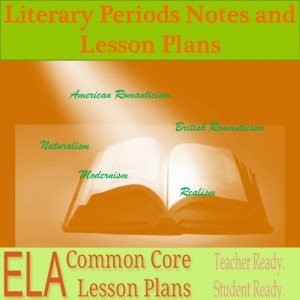Modernism
Don’t confuse the Modernists movement with the standard dictionary definition of modern. Modernism in Literature is not a chronological designation; rather it consists of literary work possessing certain loosely defined characteristics.
Looking for convenient notes on literary periods with handouts and graphic organizers? This downloadable/printable “Literary Periods” pdf includes a one page handout for each of the following literary periods: British Romanticism, American Romanticism, Naturalism, Realism, and Modernism. Along with the one-page notes handout, there’s a lesson plan, complete for each period. The file also contains two charts for each literary period. One chart is filled out with an exemplary work from the period. The other chart is blank for students to complete. I also threw in a Cornell Notes template and a fun vocabulary lesson. It’s awesome. Find more like it at Teacher Guide Central.
ELA Common Core Standards Covered
Teaching Modernism in Literature and instructing students to find aspects of Modernism in the literature they read covers the following ELA Common Core Standards.
- RL.9-10.1 Cite strong and thorough textual evidence to support analysis of what the text says explicitly as well as inferences drawn from the text.
- RL.9-10.2 Determine a theme or central idea of a text and analyze in detail its development over the course of the text, including how it emerges and is shaped and refined by specific details; provide an objective summary of the text.
- RL.9-10.5 Analyze how an author’s choices concerning how to structure a text, order events within it (e.g., parallel plots), and manipulate time (e.g., pacing, flashbacks) create such effects as mystery, tension, or surprise.
- RL.9-10.6 Analyze a particular point of view or cultural experience reflected in a work of literature from outside the United States, drawing on a wide reading of world literature (British Modernism).
- W.9-10.9 Draw evidence from literary or informational texts to support analysis, reflection, and research.
What is Modernism?
Modernist Literature shares the following characteristics.
- It is marked by a strong and intentional break with tradition. This break includes a strong reaction against established religious, political, and social views.
- Modernist writers believe the world is created in the act of perceiving it; that is, the world is what we say it is.
- They believe there is no such thing as absolute truth. All things are relative.
- Their experience is that of alienation, loss, and despair.
- Modernist writers champion the individual and celebrate inner strength.
- They believe life is unordered.
- There is a concern with the sub-conscious.
British Modernism
The horrors of World War I (1914-19), with its accompanying atrocities and senselessness became the catalyst for the Modernist movement in literature and art. Modernist authors felt betrayed by the war, believing the institutions in which they were taught to believe had led the civilized world into a bloody conflict. They no longer considered these institutions as reliable means to access the meaning of life, and therefore turned within themselves to discover the answers.
Their antipathy towards traditional institutions found its way into their writing, not just in content, but in form. Popular British Modernists include the following:
- James Joyce (from Dublin, Ireland) – His most experimental and famous work, Ulysses, completely abandons generally accepted notions of plot, setting, and characters.
- Ford Madox Ford – The Good Soldier examines the negative effect of war.
- Virginia Woolf – To the Lighthouse, as well, strays from conventional forms, focusing on Stream of Consciousness.
- Stevie Smith – Novel on Yellow Paper parodies conventionality.
- Aldous Huxley – Brave New World protests against the dangers and nature of modern society.
- D.H. Lawrence – His novels reflected on the dehumanizing effect of modern society.
- T.S. Eliot – Although American, Eliot’s The Wasteland is associated with London and emphasizes the emptiness of Industrialism.
American Modernism
Known as “The Lost Generation” American writers of the 1920s brought Modernism to the United States. For writers like Hemingway and Fitzgerald, World War I destroyed the illusion that acting virtuously brought about good. Like their British contemporaries, American Modernists rejected traditional institutions and forms. American Modernists include:
- Ernest Hemingway – The Sun Also Rises chronicles the meaningless lives of the Lost Generation. Farewell to Arms narrates the tale of an ambulance driver searching for meaning in WWI.
- F. Scott Fitzgerald – The Great Gatsby shows through its protagonist, Jay Gatsby, the corruption of the American Dream.
- John Dos Passos, Hart Crane, and Sherwood Anderson are other prominent writers of the period.
Mini Lesson: Make a chart to identify aspects of modernism. In the left column list the “characteristics of modernism”; in the middle column find “specific passages”; in the right column “write an analysis” of the passage.
Genres of Literature
Teaching literary genres helps provide context and understanding.
Last Updated on March 11, 2016 by Trenton Lorcher

